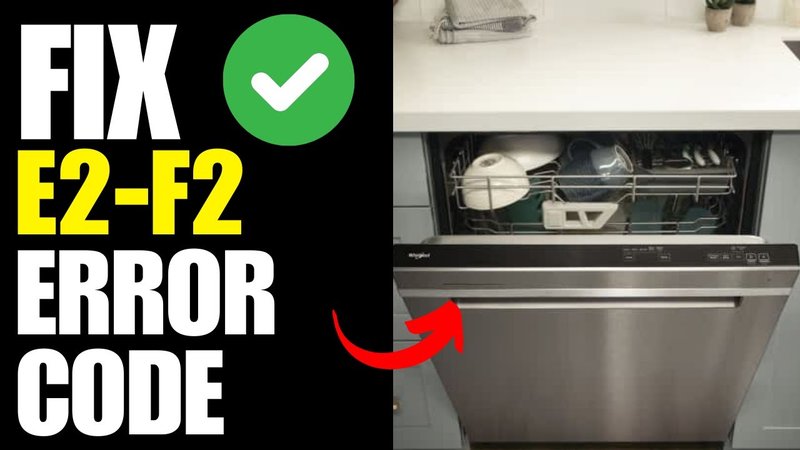
Understanding what this E2 error code signifies is key to figuring out what’s going on with your dishwasher. Think of it like when your car’s check-engine light comes on—it doesn’t necessarily mean you need a new car, but it does mean you should take a closer look. The E2 error code typically signals there’s a problem with the draining process of the dishwasher. It could be a minor issue that you can easily fix, or it might require a bit more attention. So, let’s dive deep into what this means for you and whether it’s safe to continue using your appliance.
What Does Error Code E2 Mean?
When your Whirlpool dishwasher throws up an E2 error code, it’s essentially saying, “Help! I can’t drain properly.” Picture it like trying to empty a bathtub with a clogged drain—it’s just not gonna happen smoothly. Your dishwasher relies on a series of components to move water in and out, and if any part of this system isn’t functioning correctly, it can lead to water not draining as it should.
Most often, the E2 error is related to either a blocked drain hose, a faulty pump, or a clogged filter. Imagine your dishwasher trying to push all that dirty water away, but it’s like running into a traffic jam. The error code is a result of that traffic jam, alerting you to check under the hood for any obstructions or mechanical issues. Sometimes, it might also be an electrical fault—similar to a circuit being tripped—which requires closer inspection.
Before you start worrying, know that often these issues can be resolved without a trip to the repair shop. By cleaning out the filters, ensuring the drain hose is clear, or resetting the device, many users have found success in fixing the E2 problem themselves. But how can you proceed safely to ensure that you’re not causing further damage?
Understanding the Potential Risks
Okay, now you know the basics of what the E2 error code means, but is it safe to continue using your dishwasher with this code flashing? Here’s the deal: Using a dishwasher with a known issue, like an E2 error, is a bit like trying to drive a car with a flat tire. You might get by for a bit, but eventually, you’ll run into some serious trouble.
When a dishwasher can’t drain properly, you’re risking water spillages, which could lead to water damage on your floors or cabinets. Over time, stagnant water can cause mold and mildew to develop—not exactly what you want in your kitchen. Plus, if there’s an underlying mechanical issue, continuing to run the dishwasher under these conditions can put further strain on its components, potentially leading to bigger, more costly repairs down the line.
If you notice the error code, turning off and unplugging the dishwasher until you figure out the problem can prevent additional damage. It’s always better to be safe than sorry, and for first-time DIYers, approaching the situation cautiously is key.
Steps to Resolve the E2 Error Code
You’re probably curious about how to tackle this error head-on without immediately calling in the professionals. First, ensure the dishwasher is turned off and unplugged to prevent any electrical shocks—safety first. Picture this as giving your appliance a little time-out so you can assess it in peace.
Start by checking the filter and the drain for any visible blockages. These can accumulate food particles and debris over time—much like a kitchen sink getting clogged with leftovers. If the filter is dirty, give it a good clean. For the drain hose, see if it’s kinked or blocked, which could impede water flow. Straightening or clearing it might just solve your problem.
If these steps don’t eliminate the issue, the problem could lie with the pump or other internal components. In such cases, you might need to consult the manual or reach out to a professional for a more detailed inspection. But remember to take each step slowly—rushing could lead further down the path of damage.
Preventative Measures and Maintenance Tips
So, how can you avoid seeing that E2 error again in the future? Maintaining your dishwasher is much like keeping your teeth clean—preventive measures can save you from future pain! Regular cleaning and inspection are key to keeping everything in tip-top shape.
Every month, take a little time to clean out the interior of your dishwasher, including the filters and the spray arm. Keeping these components clean and free from debris makes it easier for water to flow freely, thus preventing clogs and, ultimately, annoying error codes. Regular maintenance is just like keeping a plant healthy—give it a little TLC, and it’ll thrive.
Consider running an empty cycle with a cup of vinegar every now and then. Vinegar acts as a natural cleaner, helping to break down hard water deposits and any residue buildup. It’s a bit like giving your dishwasher a spa day. And while you’re at it, always scrape off food residues before loading your dishes. It might sound simple, but it does wonders for preventing those dreaded clogs.
At the end of the day, understanding your appliances and keeping them well-maintained are the best ways to ensure their longevity and reliability. So, go ahead and give your dishwasher a little attention now and then—it’ll save you time, effort, and money in the long run!